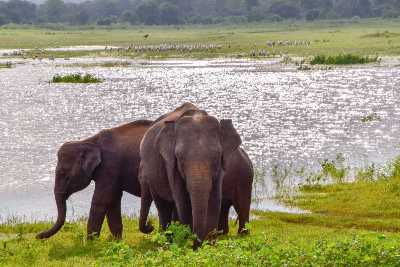Wilpattu National Park
Covering an area of over 130,000 hectares, Wilpattu is the largest national park in Sri Lanka. The park has got its name from the tens of floodplain lakes, called ‘villus’ in Sinhala, and has an astonishing diversity of flora and fauna. It is home to over 30 mammal species, including leopard, sloth bear, Sri Lankan elephant and spotted deer. Also, various wetland bird species such as the pin tail, whistling teal spoonbill, and white ibis can be found in the serene landscapes of Wilpattu.
Originally, Wilpattu has declared a wildlife sanctuary in 1905 and designated a National Park in 1938. Before the Civil War, it was one of the most popular parks in Sri Lanka, but in 1985 it was shut down following an attack on its wardens by LTTE cadres. The park was reopened in 2010 and started welcoming visitors again.
Climate and Vegetation in Wilpattu
Situated in the dry zone, the average temperature in Wilpattu is around 27 Celsius and the mean annual rainfall is approximately 1000 mm. However, the park with its dense forests and glimmering little lakes feels all but dry. This is due to rainfall patterns and the 2 monsoons this region receives. The rainiest time of the year is from September to December the north-eastern monsoon falls on Wilpattu, and the inter-monsoon season is between March and April. The period of drought extends from May to early September.
Special features of Wilpattu National Park are the shallow lakes, and rainwater-filled lakes called villus. More than 40 villus, ranging from about 2 to 400 hectares, are scattered around the park, the largest being the Periya Vila.
In Wilpattu, there are three types of vegetation: Littoral vegetation, including salt grass and low scrub immediately adjacent to the beach, and monsoon forest with tall emergents, such as palu (Manilkara hexandra), and satin (Chloroxylon swietenia), milla (Vitex altissima), weera (Drypetes sepiaria), ebony (Disopyros ebenum) and wewarna (Alseodaphne semecapriflolia).

Wildlife in Wilpattu
Wilpattu has an exceptional diversity and density of animals and birds you can discover. It is home to 31 species of mammals including the Sri Lankan elephant (Elephas maximus), sloth bear (Melursus ursinus), leopard (Panthera pardus kotiya) and water Buffalo (Bubalus bubalis).
Reptiles, such as rat snakes, Indian python, common cobra, mugger crocodile, pond turtle and soft-shelled turtle, can be spotted here also, as well as various species of birds, including garganey (Anas querquedula), pin tail (Anas acuta), whistling teal (Dendrocygna javanica), spoonbill (Platalea leucorodia), white ibis (Threskiornis malanocephalus), large white egret (Egretta alba modesta), cattle egret (Bubulcus ibis) and purple heron (Ardea purpurea).

Safari at Wilpattu
1. Morning Safari (6.00 am-11.00 am)
2. Afternoon Safari (2.30 pm – 6.00 pm)
3. Full-day Safari (5.45 am -6.00 pm)
The safari would take place with an experienced safari driver in specially modified comfortable jeeps for a unique safari experience. The tour could be more customized for guests for their preferences (Family safari, honeymoon safari, photography safari etc.).

Tour in Brief
You will Meet the safari Driver at the pickup location and drive to the National Park by the safari jeep. For the morning half-day tour, the starting time will be at 6 a.m. while the afternoon tour begins at 2.30 p.m.
After entering the national park, you will be able to spot several species of birds and other animals that have made their homes in this sanctuary. You will be taken through most of the Wilpattu National Park, covering the wetlands, grasslands, forest patches, etc. Safari drivers will make longer stops at certain watering holes for unique photography opportunities.
Finishing the safari, either around 11 a.m. or around 6 p.m. you will be dropped at the place you were picked up before.
